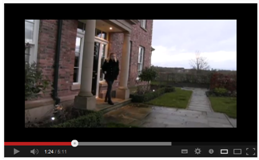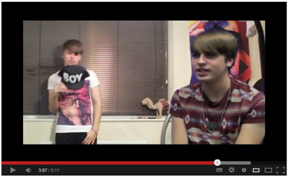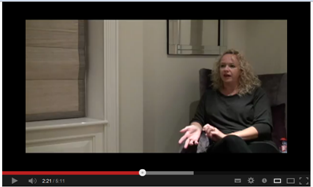To construct our documentary the main resource we used was Premiere Pro
CS5 Adobe, it took us a while to get a hang of this software but after a few
days of using it we began to understand it more.

 We also organised the background mise en scene to
We also organised the background mise en scene toreflect the topic or personality of the subject – this was most successful in Holly’s interview. Blue screen/chroma key was used to put relevant images/footage behind the subject, for example – we had footage of various magazine front covers for the background of Gemma’s interview as she was talking about the general media’s influence on young people and we used images of Chris and his merchandise behind his own interview. All of the interviews worked nicely as they all had backgrounds reflecting what they were talking about.
We also placed relevant information at the bottom of the screen during the interviews to state the person’s name, age and who they were. We also created a few montages to resemble some of the characters, for example when introducing Holly we had the narrator talking about her whilst she was walking to her flashy car in front of her big house, we filmed this from lots of different angles and added up-beat music to make it fun. We also did a short montage of Chris holding different pieces of his merchandise to show the audience.

 During the editing process we also
used archive footage to illustrate past events and to show the audience who our
interviewees were talking about, for example, the images of Kate Moss snorting
cocaine and the image of Rihanna after the abuse by Chris Brown. Using
different transitions for the images to bring them into the interview nicely.
We had inserted lots of different cutaways throughout the interviews to
illustrate what our interviewees were talking about.
During the editing process we also
used archive footage to illustrate past events and to show the audience who our
interviewees were talking about, for example, the images of Kate Moss snorting
cocaine and the image of Rihanna after the abuse by Chris Brown. Using
different transitions for the images to bring them into the interview nicely.
We had inserted lots of different cutaways throughout the interviews to
illustrate what our interviewees were talking about. The camera we used throughout the making of the documentary was a Sony HXR, MC2000E; Solid State Camera with inbuilt hard drive and USB device, these cameras had headphones so we could hear everything we were recording so we knew exactly how it would sound for somebody else watching. The camera had a screen which showed how the frame would look on the computer which made it easy for us to get the right angles and positions, we interviewed people important to the subject using these cameras with a tripod to make the camera steady, we did not feature the interviewer and the questions asked by the interviewer were edited out, the interviewee always looked across the camera at the interviewer, not at the camera, this makes it an interview not a broadcast/statement. We lit the interviewee’s face from the front not from behind so we had a clear view of their face.
All of our interviews were filmed using
different shot sizes and framing, this provided variety, we used a wide shot
for Holly’s interview, medium shots for Jen’s and Gemma’s interviews etc.

We used establishing shots to identify locations of where we were and where people lived for example during Holly’s montage of her walking to the car we used an establishing shot to show off her big house.
For the voiceover narration, we used the Sony HXR camera to record him reading a carefully written script of which anchors the meanings of the visual images and archive footage and guides the viewers understanding of the topic. Our narrator uses an authoritative voice. We used some non-diegetic musical soundtracks behind the voice over, raising the volume when there is no voice-over narration/talking.
The computer we used was a Dell XPS machine with I7 processes.
We used Photoshop CS5 Adobe to create our poster.
Our main source we used from the internet for our media product and research planning were Google for general image/information searches and archive footage.

 We also used
YouTube for archive footage and to also see what other people thought about
celebrity role models, we used videos such as ‘worst celebrity role model’ and
‘good celebrities gone bad’.
We also used
YouTube for archive footage and to also see what other people thought about
celebrity role models, we used videos such as ‘worst celebrity role model’ and
‘good celebrities gone bad’.
We also used the internet for Facebook
to share our documentary with some friends and family to see what their views
were.
 Blogger was our main used source
throughout the coursework as this is where we updated and kept all of our work.
We created a blog and had different headings that made up the full coursework.
The headings were; Documentary Analysis x6, Brainstorming- Ideas for
Documentary, Initial Plans, Target Audience Research, Brainstorm Content for
Documentary, Formal Proposal for Documentary, Research for Documentary, Running
Order, Planning, Construction, Filming, Editing Decision List, Editing,
Scripting Voiceover, Voiceover Recording, Codes and Conventions of Radio
Trailers, Scripting Radio Trailer, Recording and Editing Radio Trailer, Codes
and Conventions of Newspaper Advertisements, Drafting Newspaper Advertisements,
Newspaper Advertisement Production, Audience Feedback and Evaluation.
Blogger was our main used source
throughout the coursework as this is where we updated and kept all of our work.
We created a blog and had different headings that made up the full coursework.
The headings were; Documentary Analysis x6, Brainstorming- Ideas for
Documentary, Initial Plans, Target Audience Research, Brainstorm Content for
Documentary, Formal Proposal for Documentary, Research for Documentary, Running
Order, Planning, Construction, Filming, Editing Decision List, Editing,
Scripting Voiceover, Voiceover Recording, Codes and Conventions of Radio
Trailers, Scripting Radio Trailer, Recording and Editing Radio Trailer, Codes
and Conventions of Newspaper Advertisements, Drafting Newspaper Advertisements,
Newspaper Advertisement Production, Audience Feedback and Evaluation. 

































